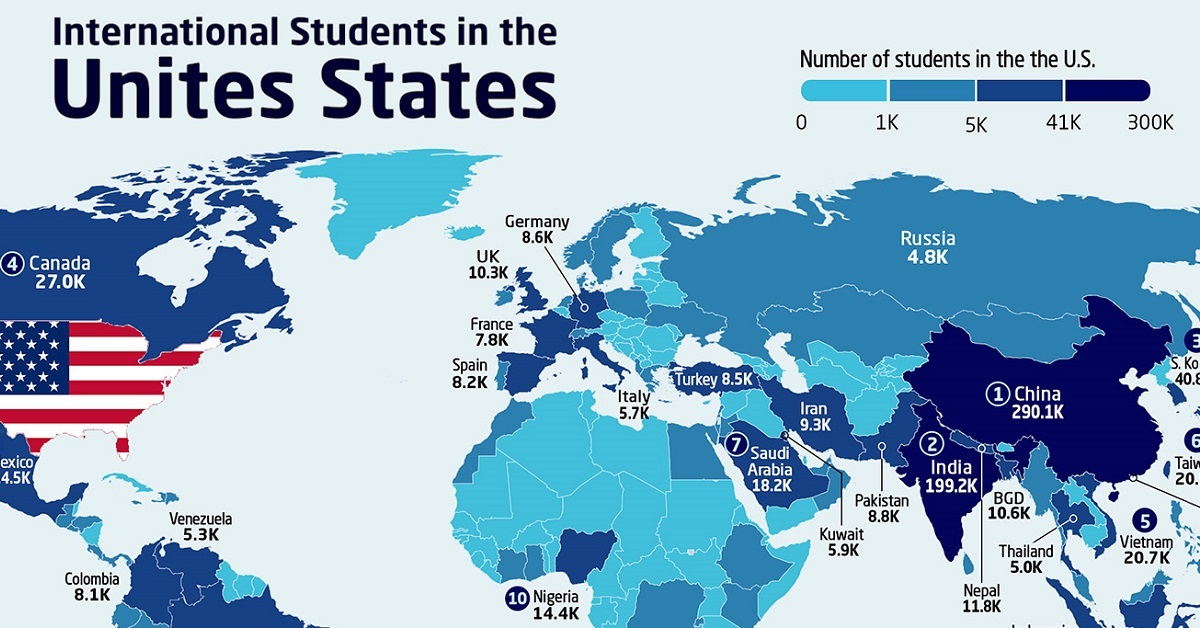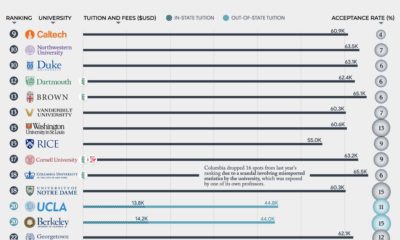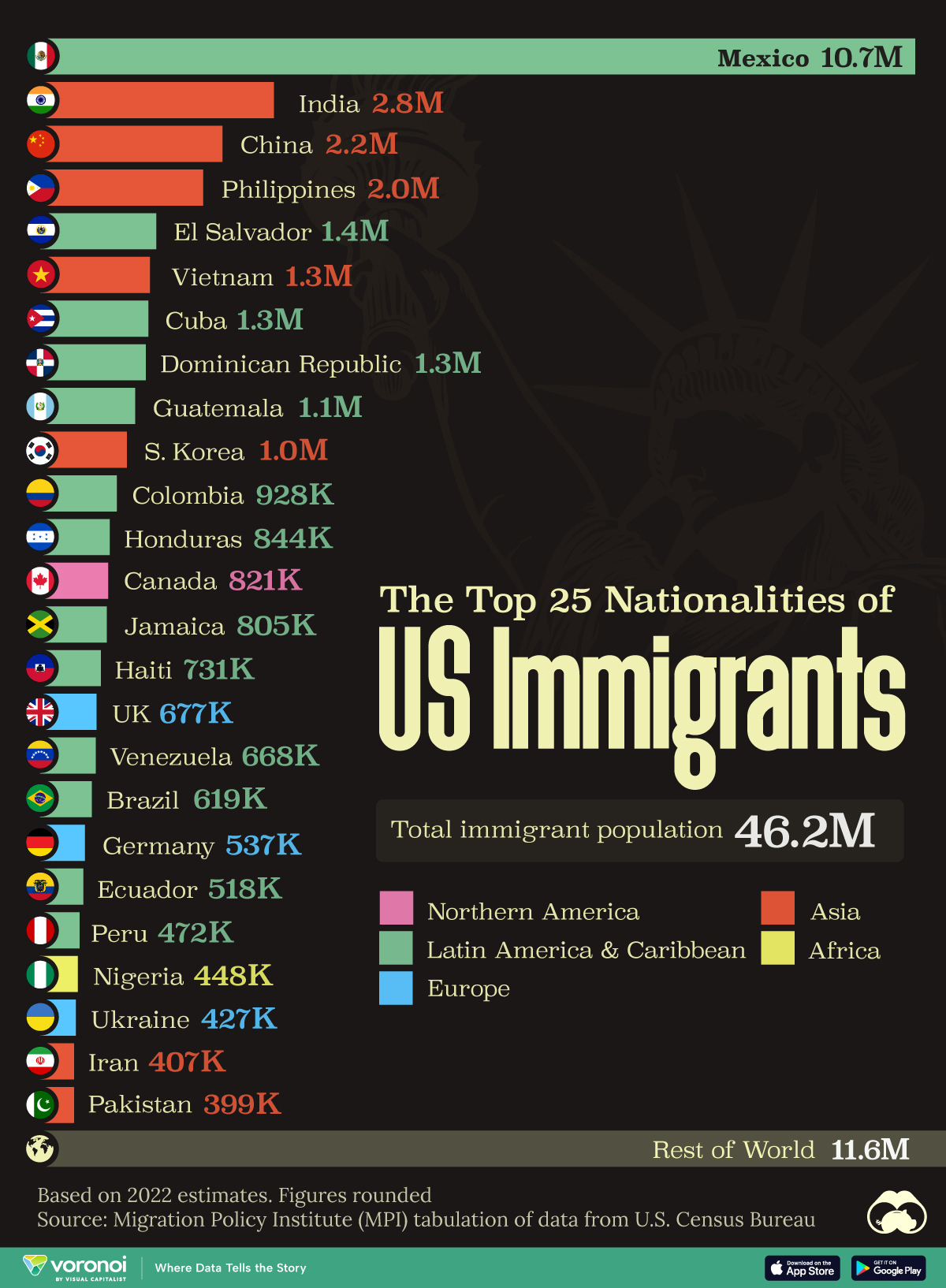Misc
Where Do International Students in the U.S. Come From?
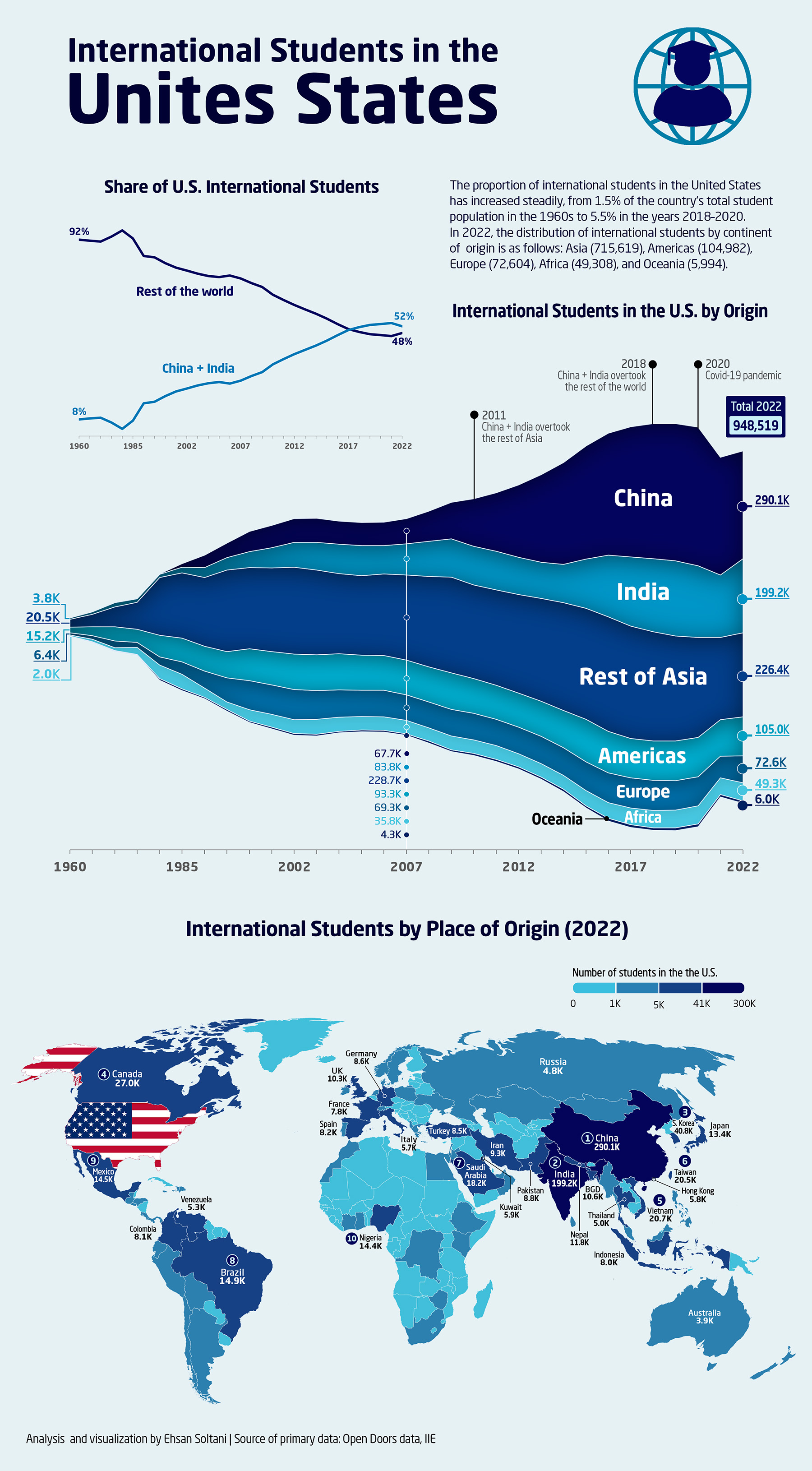
Where Do International Students in the U.S. Come From?
The proportion of international students in U.S. higher education institutions has increased steadily, from 1.5% of the country’s total students in the 1960s to 5.5% in the early 2020s.
Using 2022 data from the International Education Exchange (IIE), this visualization from Ehsan Soltani breaks down where these students come from.
The International Student Population
The United States has always attracted students seeking quality education at its many world-class universities and opportunities in the country’s job market.
After a drop in recent years due to COVID-19 restrictions, American institutions registered a 3.8% increase in international student participation in 2022.
There were 948,519 international students at U.S. colleges and universities last year.
Asian students represent 75% of the total, with Chinese (30%) and Indians (21%) adding up to over half the count. Oceania is the place of origin with the fewest international students enrolled in the U.S., making up only 0.6% of the total.
| Place of Origin | 1950 | 1970 | 1990 | 2020 | 2022 |
|---|---|---|---|---|---|
| Oceania | 198 | 2,077 | 4,010 | 7,473 | 5,994 |
| Africa | 901 | 7,607 | 24,570 | 48,679 | 49,308 |
| Europe | 5,569 | 18,524 | 46,040 | 78,321 | 72,604 |
| Americas | 10,406 | 38,406 | 66,680 | 106,196 | 104,982 |
| India | 1,359 | 11,329 | 26,240 | 193,124 | 199,182 |
| China | - | 19 | 33,390 | 372,532 | 290,086 |
| Rest of Asia | 7,707 | 52,963 | 185,810 | 269,164 | 226,351 |
According to Open Doors, for the first time in a decade, there were more graduate students (41%) than undergraduates (36%) studying in the United States in 2022.
| Institutional Type | Number of Students (2022) |
|---|---|
| Doctorate-granting Universities | 738,555 |
| Master's Colleges and Universities | 105,680 |
| Baccalaureate Colleges | 35,569 |
| Associate's Colleges | 49,099 |
| Special Focus Institutions | 19,616 |
| Total | 948,519 |
Since the COVID-19 pandemic, many colleges and universities have started to offer online courses. Still, the vast majority of students attended classes in person last year.
A Billionaire Business
International students continue to be a priority for the U.S. higher education sector, contributing $32 billion to the country’s economy in 2022.
With the demographic decline in U.S. domestic higher education enrollment, many colleges and universities are strategically focusing on international students.
According to IIE, 89% of U.S. colleges and universities indicated that 2023/24 applications are up or have stayed the same as the previous year.

This article was published as a part of Visual Capitalist's Creator Program, which features data-driven visuals from some of our favorite Creators around the world.
Misc
The Top 25 Nationalities of U.S. Immigrants
Mexico is the largest source of immigrants to the U.S., with almost 11 million immigrants.
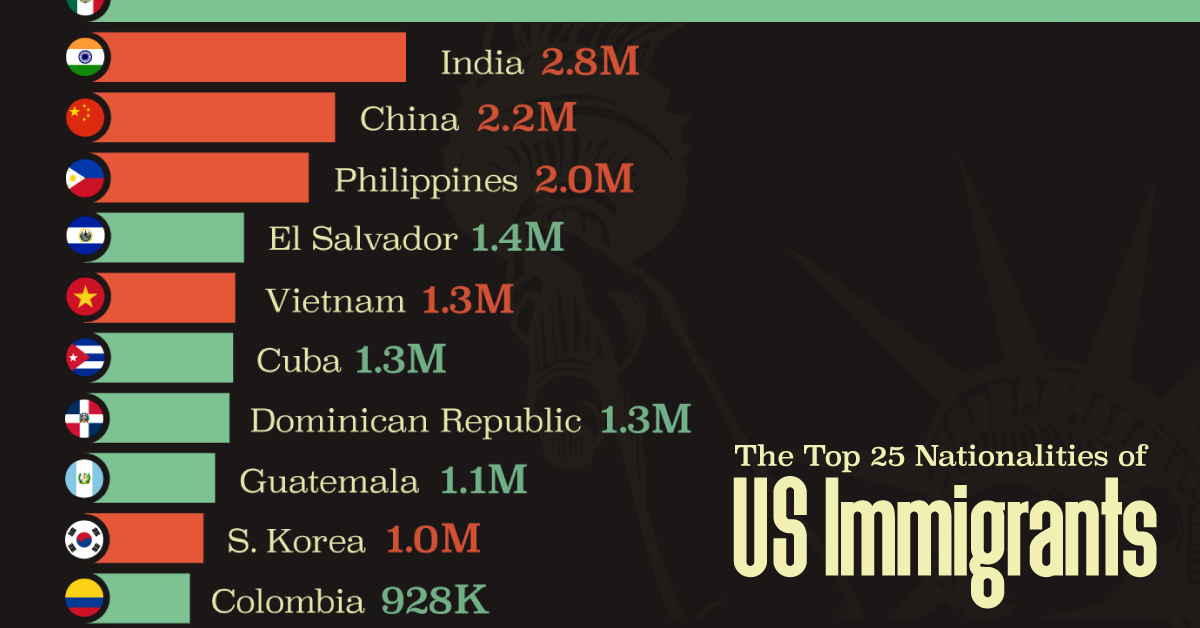
The Top 25 Nationalities of U.S. Immigrants
This was originally posted on our Voronoi app. Download the app for free on iOS or Android and discover incredible data-driven charts from a variety of trusted sources.
The United States is home to more than 46 million immigrants, constituting approximately 14% of its total population.
This graphic displays the top 25 countries of origin for U.S. immigrants, based on 2022 estimates. The data is sourced from the Migration Policy Institute (MPI), which analyzed information from the U.S. Census Bureau’s 2022 American Community Survey.
In this context, “immigrants” refer to individuals residing in the United States who were not U.S. citizens at birth.
Mexico Emerges as a Leading Source of Immigration
Mexico stands out as the largest contributor to U.S. immigration due to its geographical proximity and historical ties.
Various economic factors, including wage disparities and employment opportunities, motivate many Mexicans to seek better prospects north of the border.
| Country | Region | # of Immigrants |
|---|---|---|
| 🇲🇽 Mexico | Latin America & Caribbean | 10,678,502 |
| 🇮🇳 India | Asia | 2,839,618 |
| 🇨🇳 China | Asia | 2,217,894 |
| 🇵🇭 Philippines | Asia | 1,982,333 |
| 🇸🇻 El Salvador | Latin America & Caribbean | 1,407,622 |
| 🇻🇳 Vietnam | Asia | 1,331,192 |
| 🇨🇺 Cuba | Latin America & Caribbean | 1,312,510 |
| 🇩🇴 Dominican Republic | Latin America & Caribbean | 1,279,900 |
| 🇬🇹 Guatemala | Latin America & Caribbean | 1,148,543 |
| 🇰🇷 Korea | Asia | 1,045,100 |
| 🇨🇴 Colombia | Latin America & Caribbean | 928,053 |
| 🇭🇳 Honduras | Latin America & Caribbean | 843,774 |
| 🇨🇦 Canada | Northern America | 821,322 |
| 🇯🇲 Jamaica | Latin America & Caribbean | 804,775 |
| 🇭🇹 Haiti | Latin America & Caribbean | 730,780 |
| 🇬🇧 United Kingdom | Europe | 676,652 |
| 🇻🇪 Venezuela | Latin America & Caribbean | 667,664 |
| 🇧🇷 Brazil | Latin America & Caribbean | 618,525 |
| 🇩🇪 Germany | Europe | 537,484 |
| 🇪🇨 Ecuador | Latin America & Caribbean | 518,287 |
| 🇵🇪 Peru | Latin America & Caribbean | 471,988 |
| 🇳🇬 Nigeria | Africa | 448,405 |
| 🇺🇦 Ukraine | Europe | 427,163 |
| 🇮🇷 Iran | Middle East | 407,283 |
| 🇵🇰 Pakistan | Asia | 399,086 |
| Rest of World | 11,637,634 | |
| Total | 46,182,089 |
Mexicans are followed in this ranking by Indians, Chinese, and Filipinos, though most immigrants on this list come from countries in the Latin American and Caribbean region.
On the other hand, only three European countries are among the top sources of U.S. immigrants: the UK, Germany, and Ukraine.
Immigration continues to be a significant factor contributing to the overall growth of the U.S. population. Overall population growth has decelerated over the past decade primarily due to declining birth rates.
Between 2021 and 2022, the increase in the immigrant population accounted for 65% of the total population growth in the U.S., representing 912,000 individuals out of nearly 1.4 million.
If you enjoyed this post, be sure to check out Visualized: Why Do People Immigrate to the U.S.? This visualization shows the different reasons cited by new arrivals to America in 2021.
-

 Personal Finance1 week ago
Personal Finance1 week agoVisualizing the Tax Burden of Every U.S. State
-

 Misc6 days ago
Misc6 days agoVisualized: Aircraft Carriers by Country
-

 Culture7 days ago
Culture7 days agoHow Popular Snack Brand Logos Have Changed
-

 Mining1 week ago
Mining1 week agoVisualizing Copper Production by Country in 2023
-

 Misc1 week ago
Misc1 week agoCharted: How Americans Feel About Federal Government Agencies
-

 Healthcare1 week ago
Healthcare1 week agoWhich Countries Have the Highest Infant Mortality Rates?
-

 Demographics1 week ago
Demographics1 week agoMapped: U.S. Immigrants by Region
-

 Maps1 week ago
Maps1 week agoMapped: Southeast Asia’s GDP Per Capita, by Country

